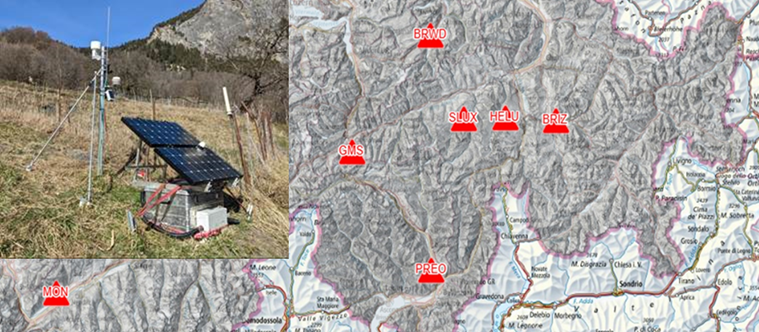Detection, characterization and monitoring of instabilities with seismic technologies
Borgeat, X., Glueer, F., Häusler, M., Hobiger M. and D. Fäh (2024). On the variability of the seismic response of the active rock slope in Brienz/Brinzauls (Switzerland). Planned for submission to Geophysical Journal International.
Burjánek, J., Gischig, V., Moore, J.R. and Fäh, D. (2018). Ambient vibration characterization and monitoring of a rock slope close to collapse. Geophys. J. Int. 212, 297-310. https://academic.oup.com/gji/article/212/1/297/4331640
Burjanek, J., Kleinbrod, U., & Fäh, D. (2019). Modeling the Seismic Response of Unstable Rock Mass With Deep Compliant Fractures. Journal of Geophysical Research-Solid Earth 124)12), 13039-13059. doi: 10.1029/2019JB018607
Cauzzi, C., Fäh, D., Wald, D.J., Clinton, J., Losey, S. and S. Wiemer (2018). ShakeMap-based prediction of earthquake-induced mass movements in Switzerland calibrated on historical observations. Natural Hazards 92 (2), 1211-1235.
Glueer, F., Häusler, M., Gischig, V. and Fäh, D. (2021). Coseismic Stability Assessment of a Damaged Underground Ammunition Storage Chamber Through Ambient Vibration Recordings and Numerical Modelling. Front. Earth Sci. doi: 10.3389/feart.2021.773155
Glueer, F., Mreyen, A.-S., Cauchie, L., Havenith, H.-B., Bergamo, P., Halló, M., & Fäh, D. (2024). Integrating Seismic Methods for Characterizing and Monitoring Landslides: A Case Study of the Heinzenberg Deep-Seated Gravitational Slope Deformation (Switzerland). Geosciences 14 (2), 28. doi: 10.3390/geosciences14020028
Häusler, M., Michel, C., Burjanek, J., & Fäh, D. (2019). Fracture Network Imaging on Rock Slope Instabilities Using Resonance Mode Analysis. Geophysical Research Letters 46 (12), 6497-6506. doi: 10.1029/2019gl083201
Häusler, M., Glueer, F., Burjánek, J., & Fäh, D. (2020). Chasing a hidden fracture using seismic refraction tomography: case study Preonzo, Switzerland. EGU2020-9701. In: Paper presented at the EGU General Assembly. doi: 10.5194/egusphere-egu2020-9701
Häusler, M., Michel, C., Burjánek, J., and Fäh, D. (2021). Monitoring the Preonzo rock slope instability using resonance mode analysis. J. Geophys. Res. Earth Surf. doi: 10.1029/2020JF005709
Häusler, M., Gischig, V., Thöny, R., Glueer, F. and Fäh, D. (2021). Monitoring the changing seismic site response of a fast-moving rockslide (Brienz/Brinzauls, Switzerland). Geophysical Journal International 229 (1), 299-310. doi: 10.1093/gji/ggab473
Häusler, M., Glueer, F., & Fäh, D. (2024). The changing seismic site response of the Brienz/Brinzauls rock slope instability: insights from 5 years of monitoring before, during and after a partial collapse in June 2023. ICL open access book series “Progress in Landslide Research and Technology”, 2-12.
Kleinbrod, U., Burjánek, J., Fäh, D. (2017). On the seismic response of instable rock slopes based on ambient vibration recordings. Earth. Planets and Space. doi: 10.1186/s40623-017-0712-5
Kleinbrod, U., Huggentobler, M., Burjánek, J., Aman, F., Fäh, D. (2017). A comparative study on seismic response of two unstable rock slopes within same tectonic setting but different activity level. Geophys. J. Int 211 (3), 1428-1448. doi: 10.1093/gji/ggx376
Kleinbrod, U., Burjanek, J., & Fah, D. (2019). Ambient vibration classification of unstable rock slopes: A systematic approach. Engineering Geology 249, 198-217. doi: 10.1016/j.enggeo.2018.12.012
Oprsal, I., Thun, J., Burjánek, J. and D. Fäh (2020). Measurements and modeling of the post-failure micro-deformations and tilts of the Preonzo unstable slope, Alpe di Roscioro, Switzerland. Engineering Geology. doi: 10.1016/j.enggeo.2020.105919
Weber, S., Fäh, D. Beutel., J., Faillettaz, J., Gruber, S., Vieli, A. (2018). Ambient seismic vibrations in steep bedrock permafrost used to infer variations of ice-fill in fractures. Earth and Planetary Science Letters, 119-127. doi: 10.1016/j.epsl.2018.08.042
Weber, S., Beutel, J., Häusler, M., Geimer, P.R., Fäh, D. and Moore, J.R (2021). Spectral amplification of ground motion linked to resonance of large-scale mountain landforms. Earth and Planetary Science Letters. doi: 10.1016/j.epsl.2021.117295
